Pagan Light_Dreams of Freedom and Beauty in Capri by Jamie James

Author:Jamie James [James, Jamie]
Language: eng
Format: epub
Tags: Travel, history
ISBN: 9780374142766
Google: Y4tbDwAAQBAJ
Amazon: 0374142769
Goodreads: 40121969
Publisher: Farrar, Straus and Giroux
Published: 2019-03-19T00:00:00+00:00
The key fits the lock exactly, a concise thumbnail biography of Romaine Brooks more than a fictional impression of her, with the possible exception of its characterization of the love affairs, which is difficult to confirm. The record of Brooksâs private life is vague: the main source is her memoir, which is discreet more than secretive. She refers to every one of her female lovers as âmy friend.â
Hall omits to mention that the Italian poet who was the subject of the portrait bought by the Musée du Luxembourg was Gabriele DâAnnunzio, with whom Brooks carried on an intense love affair. A reader with no other source of information than Brooksâs memoir would conclude that he was the great love of her life. Several writers have been called the last Romantic, but DâAnnunzioâs claim to the distinction is stronger than most, both because of the florid exuberance of his poetry and his novels of doomed love and specifically because of his parallel career as a man of revolutionary action, in the mold of Byron. Today, DâAnnunzio may be just as well-known as the most successful Don Juan of his day, with a catalogue of conquests to rival the canonical 1,003 of Mozartâs Don Giovanni, as for his literary works; yet at the time that Romaine Brooks succumbed to his charms, DâAnnunzio was the most influential Italian poet of his era. His intensely romantic novels were international bestsellers, and his historical stage plays, such as La gioconda and Francesca da Rimini, were acclaimed as masterpieces and rapturously received by the public. His posthumous reputation has suffered in part because of his sexual mania, in part because he did not follow the modernist orthodoxy, and in particular because Mussolini embraced him as the national poet of the Fascists.
The potency of DâAnnunzioâs seductive charm was all the more remarkable because his person was, by all accounts, repellent. Liane de Pougy, a celebrated courtesan who eluded his grasp, described him as âa frightful gnome with red-rimmed eyes and no eyelashes, no hair, greenish teeth, bad breath, [and] the manners of a mountebank.â Brooks met him at a lunch given by the Italian artist Leonetto Cappiello, where she saw in him âthe great lapidé of our times.â One of the principal themes of Brooksâs memoir is her sympathy and identification with heroic individuals who are stoned (lapidé) by the Philistine mob, martyrs for art. âHis true personality was all but eclipsed by his notorious reputation,â she wrote of DâAnnunzio. âStoned out of his own country, he was to face even more stoning in Paris.â
Her admiration for DâAnnunzio was electrified when they first met, by a chance remark. Cappielloâs vibrantly colorful posters for Cinzano and Campari were plastered all over Paris, and when he showed his guests some new designs, DâAnnunzio whispered in Brooksâs ear, âAnd to think how much can be expressed without any color at all.â Impulsively, she invited him to come see her paintings. âWhen he entered the studio,â she wrote, âDâAnnunzio, paying scant
Download
This site does not store any files on its server. We only index and link to content provided by other sites. Please contact the content providers to delete copyright contents if any and email us, we'll remove relevant links or contents immediately.
| General | Channel Islands |
| England | Northern Ireland |
| Scotland | Wales |
Spell It Out by David Crystal(36022)
Underground: A Human History of the Worlds Beneath Our Feet by Will Hunt(11997)
A Year in the Merde by Stephen Clarke(5298)
Venice by Jan Morris(2513)
Claridge's: The Cookbook by Nail Martyn & Erickson Meredith(2348)
My Paris Kitchen: Recipes and Stories by Lebovitz David(2230)
A TIME OF GIFTS by Patrick Leigh Fermor(2142)
The Plantagenets by Dan Jones(2023)
Welcome to the Goddamn Ice Cube by Blair Braverman(1982)
The Finnish Way by Katja Pantzar(1921)
From Russia with Lunch by David Smiedt(1920)
Top 10 Prague (EYEWITNESS TOP 10 TRAVEL GUIDES) by DK(1912)
Bang Poland: How To Make Love With Polish Girls In Poland by Roosh V(1909)
The Isle of Mull by Terry Marsh(1880)
A TIME TO KEEP SILENCE by Patrick Leigh Fermor(1850)
Rick Steves London 2018 by Rick Steves & Gene Openshaw(1811)
A Taste of Paris by David Downie(1800)
Insight Guides Experience Tokyo by Insight Guides(1766)
Merde in Europe by Stephen Clarke(1712)
